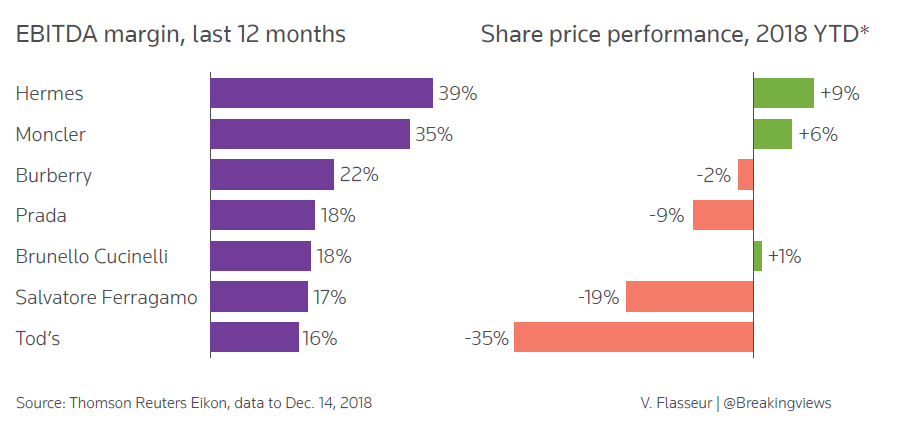By LISA JUCCA AND KAREN KWOK
Remo Ruffini could be Italy’s answer to Bernard Arnault in 2019. Since rescuing Moncler in 2003, the entrepreneur has rejuvenated the brand into a goose-down success story. There’s a long way to go before he can use the growing strength of 7.5 billion euro Moncler to create anything like Arnault’s LVMH , worth 130 billion euros. But if he fancies building the first Italian luxury aggregator, now is a good time.
Italian luxury is fragmented and valuations are historically cheap — the sector trades on 25 times expected earnings, compared to a five-year average of 28 times, Refinitiv data shows. Sales at upscale shoemaker Tod’s have been falling since 2014. Salvatore Ferragamo also struggles with revenue, and is in flux after matriarch Wanda Ferragamo’s death. Unlisted players like handbag-maker Furla may also come up for sale.

U.S. and Chinese buyers have noticed. Michael Kors paid a hefty $2.1 billion for struggling Versace in September. China’s top textile player Shandong Ruyi and conglomerate Fosun snagged Swiss brand Bally and French couture house Lanvin respectively.
Still, the rise of an EU-sceptic government in Rome embracing shaky budget policies could put a brake on global buyer enthusiasm. That gives Ruffini an opportunity to consider going beyond Moncler. The Italian is doing something right: sales jumped by 15 percent in 2017 and should do so again in 2018. His skills could be deployed to battle the generational shifts and changing consumer habits undermining some storied Italian brands.
Investors who bought Moncler shares when it debuted in 2013 have seen total returns double, beating all listed peers bar Hermes . At 35 percent, Moncler’s EBITDA margins are second only to the famed French handbag maker among luxury players in Europe. And Ruffini is no stranger to M&A: in October his family vehicle Archive bought a 49 percent stake in small Italian fashion brand Attico.
LVMH and peers Kering and Richemont are so shaped because their size brings economies of scale and diversification benefits. Although Moncler’s flagship jackets are in vogue, acquiring leather goods or watches could hedge against fickle tastes. If Ruffini can overcome Italian luxury’s traditional rivalries and get second-generation potential sellers onside, the path to Arnault-style status could be his.
